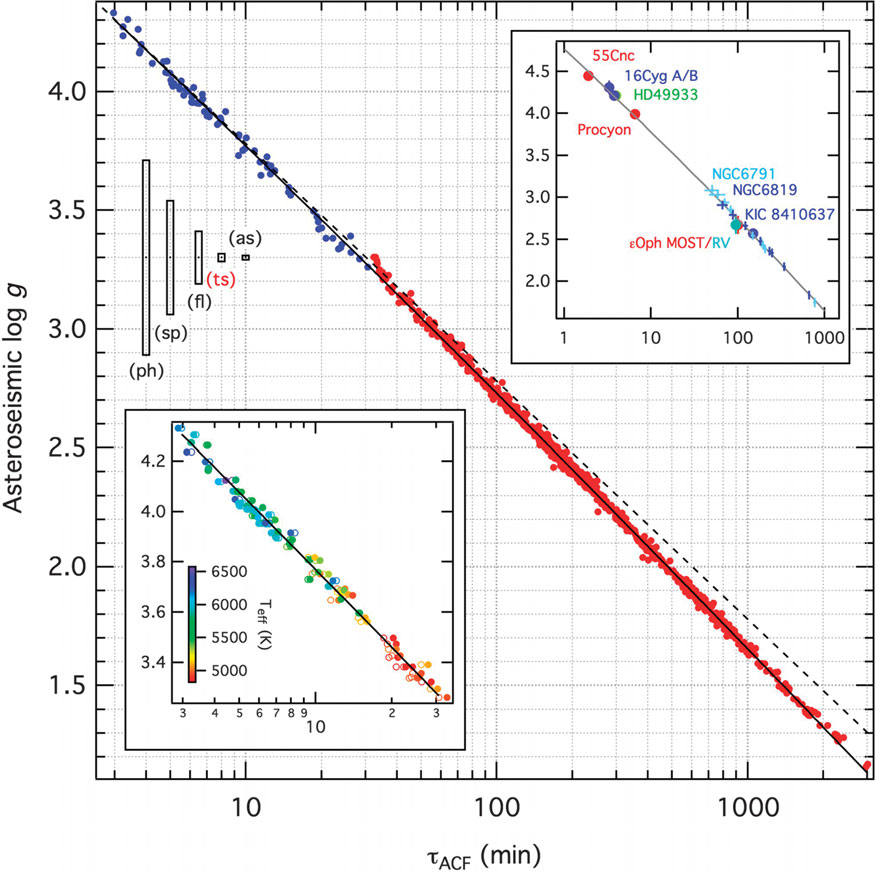Fine-tuning of stellar gravity
A new method for determining of the surface gravity of stars, based on Kepler observations of granulation improves the precision of gravity determinations to 4%. The method is viable for many more types of stars than previously possible. The method is published 1 January 2016 in a paper in Science Advances by a group of researchers including Saskia Hekker and Daniel Huber affiliated with Stellar Astrophysics Centre, Aarhus University

A new method for determining of the surface gravity of stars, based on Kepler observations of granulation improves the precision of gravity determinations to 4%. The method is viable for many more types of stars than previously possible. The method is published 1 January 2016 in a paper in Science Advances by a group of researchers including Saskia Hekker and Daniel Huber affiliated with Stellar Astrophysics Centre, Aarhus University.
A new method can improve the determination of basic parameters for many stars and their planets, and can do it faster than previously.
Knowing the magnitude of the gravity on the surface of a star enables us relatively easy to calculate a string of other stellar parmeters, such as the total mass and radius. If, as often happens, there are exoplanets orbiting the star, a precise knowledge of the parent star and its radiation will also tell us quite a lot about the planets, e.g. whether they orbit in the proper distance allowing liquid water, whether they have a solid surface and their sizes.
Unfortunately determining the surface gravity of a star is not an easy task. A small group of researchers representing universities of Wienna, Göttingen, Paris, Sydney, Vancouver and Stellar Astrophysics Centre in Aarhus has found a bypass. They work with data from the NASA Kepler space telescope, measuring extremely small variations in the light output from stars. Some of these variations are due to granulation in or close to the surface of the stars. Granulation is the same process that can be seen in a pot of water just before it boils: bubbles of hot water are streaming up towards the surface all the time. The same happens in most stars. They 'boil' in a process called convection. Stars are not made of liquids, but of gases. The heat from the energyproducing layers in the inner parts of the star finds it way outwards. Huge bubbles of gas are heated and rise towards the surface of the star. On the way up the bubbles expand because of lower pressure - the same happens with a balloon ascending in the atmosphere of the Earth. At the surface of the star the bubbles radiate their energy as starlight and the cooled gas sinks back towards the inner parts of the star in a repeated cycle.
Looking at the star from outside, we see that the surface is boiling. Bright and hot bubbles rise, and the cooler and darker gas surrounding the bright spots is seen as relatively regular edges around the bubbles. The Kepler satellite cannot observe these details on the surface of the remote stars. The boiling is visible as minor and relatively fast changes in the summed brightness of the star.
In stars of high gravity the granulation is fast and consists of many small cells all over the surface of the star. This causes small but fast variations in the light output. On the contrary, in stars of low gravity bubbles will rise slowly growing to huge sizes on the way, and this will be seen by the satellite as slow but large variations in brightness.
One might compare this again to a pot of boiling water here on Earth. We hear that the water is boiling by its simmering in the pot and we are used to this sound. If we brought the same pot and heat source to a place with lower gravity like, say, a space base on the surface of Mars, the water would still be simmering, but with a deeper sound because the bubbles due to the convection are moving slower in the lower gravity.
By analyzing the small variations in the light of a star, the team of astronomers are able to resolve them into a series of different oscillations, representing sound waves on the surface of the star. Some of the oscillation modes stem from vibrations permeating all the way through the star, because it is ringing like en enormous bell. Other oscillations are directly caused by the convection. These last ones tell about the gravity on the surface of the star. Slow oscillations tell the astronomers that this is a huge star with low gravity, and the faster the oscillations the larger the gravity.
The new method has enabled the research team to determine the gravity of stars with a precision of 4%, and we have now values for many different types of stars, both light and medium large. Previously it has been possible by indirect methods to reach a precision of only 25%, and this only for certain selected types of stars.
See the full article here.
For more information, please contact:
Ole J.Knudsen
Stellar Astrophysics Centre, Aarhus University
Phone: +45 87155597 or +45 40594520
